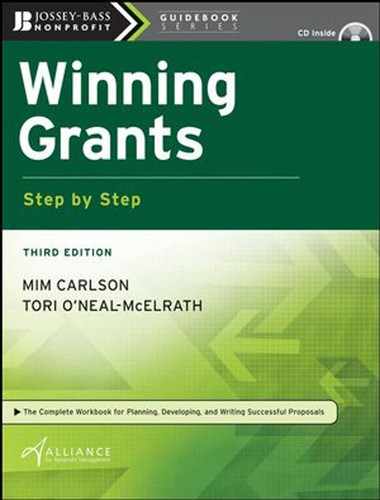Tips for Writing Good Goals and Objectives
• Make sure goals and objectives tie directly to the need statement. This is critical.
• Include all relevant parties in the target population.
• Allow plenty of time for the objectives to be accomplished. Things always take longer than planned.
• Remember that outcome objectives do not describe methods. Collaborating with the community clinics within the service area of the Some City Senior Center is a method. Stabilizing the blood sugar levels of a minimum of seventy-five monolingual Spanish-speaking seniors for three consecutive months is an outcome objective, as it describes the result of a method.
• Determine how your organization is going to measure the change projected in each objective. If you find you have no way to measure change, you probably need to rethink the objectives (more on this in Step Five). Measurement of the objective stated in the previous point might be described this way: “We will measure all participants’ blood sugar levels at the beginning of the diabetes management classes and then measure their blood sugar levels weekly for three months following their completion of the classes to determine whether their blood sugar levels are stabilized.”
• Always try to write at least one outcome objective into your plan, and determine how you will measure it. Remember to budget for evaluation activities if measuring the objective(s) will have costs associated with it.
Use Worksheet 4.1A to prepare to write your goals and objectives by focusing on outcomes. Start by writing down the goal of the program. Then describe the objectives that tie to that goal. Use the filled-out Worksheet 4.1B as a guide.
If your organization has more than one goal for its program, use a separate copy of Worksheet 4.1A for each goal. Limit the objectives to no more than four per goal.
Then write your proposal’s goals and objectives component, following the standard formula supplied at the end of the worksheet, and using the sample goals and objectives on Worksheet 4.1B as a guide. When you are finished, go through the Goals and Objectives Review Questions, in the same way you did with the review questions for your statement of need. Remember, you want to be able to answer yes to each question in the review questions.
WORKSHEET 4.1A: Goals and Objectives Exercise
Follow this standard form as you write out your objective statements: To (direction of change) + (area of change) + (target population) + (degree of change) + (time frame).
Winning Grants Step by Step,Third Edition. Copyright © 2008 by JohnWiley & Sons, Inc. All rights reserved.

WORKSHEET 4.1B: Goals and Objectives Exercise Example
Follow this standard form as you write out your objective statements: To (direction of change) + (area of change) + (target population) + (degree of change) + (time frame).
Winning Grants Step by Step,Third Edition. Copyright © 2008 by JohnWiley & Sons, Inc. All rights reserved.

Goals and Objectives Review Questions
1. Are your organization’s goals stated as results?
2. Are your organization’s outcome objectives stated as specific results that relate to a program goal?
3. Can progress in meeting your organization’s objectives be quantified and assessed?
4. Do your organization’s objectives describe the client population and a specific time frame for change?
Your nonprofit’s need statement is in order, and you have the “so what?” factor covered in the program’s goals and objectives. Let’s move on to the development of your organization’s methods, which is Step Five.
..................Content has been hidden....................
You can't read the all page of ebook, please click here login for view all page.
